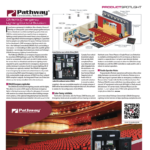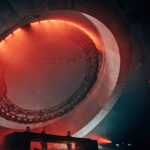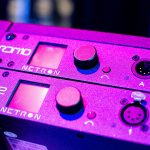Charles H. Duell, the former commissioner of the U.S. Patent and Trademark Office, said in 1899 that everything that can be invented, has been invented. Of course, everyone knows that wasn’t true until 2002 when Martin introduced the animation wheel in the MAC 2000. Then and only then had everything been invented, at least in terms of automated lighting. Sure, lots of new automated lighting products were introduced since then, but true innovation seemed to be lacking. Not anymore.
The Martin MAC III Profile is one of the first of the third generation of MAC fixtures and it has been completely redesigned from the stage floor up (or from the batten down). It uses the new Osram 1500W Lok-it single-ended short 1500-watt single-ended short arc lamp with a FastFit base and the output is very impressive. Not only can it produce an amazingly brilliant beam, but with a 5:1 zoom ranging from 11° to 55°, it can cover quite a bit of area and still do so with a lot of illuminance. You can even drop in the color mixing and effects and still come out with a lot of light.

The lighting designer side of me loves the quantity and quality of light while the geek in me is very impressed with the engineering and design of the fixture. There are lots of very innovative materials, techniques, and devices that make it unique in the industry. One of the challenges of building a light with a lot of output is keeping its size and weight to a manageable level. This challenge is met, for example, in the base by using a pressure die cast aluminum hub on which the yoke pans. When you hold it in your hand it feels very lightweight yet it is very strong. The same goes for the magnesium yoke covers, the clam shell enclosures on the head and the fixture handles. The color wheels are made of magnesium coated with ceramic and they are featherweights. You have to hold them in your hand to believe how light they are.

At 118 pounds with dimensions of 27.2 inches by 21.1 inches by 36 inches, it’s still a two-person rig; the glass and the physical size required to produce quality projections with a wide zoom range see to that. But it could have been much bigger and heavier had they not used some of these materials and techniques.
Other design features are equally impressive. The pan and tilt encoders that keep them in the proper position are absolute value encoders, meaning that they have their own internal zero reference. Most encoders have to search for a home position in the startup sequence but these self-contained encoders have a built-in zero reference.
The lamp has a “semi-hot re-strike” circuit and it will re-strike within 120 seconds of dousing. The lamp socket has a gyro-like adjustment feature instead of the familiar X-Y-Z three-axis adjustment. It’s much easier to center the lamp in the reflector and adjust the beam profile.

The cooling system is also a very unique design. It forces air directly through the optical path by channeling it through a tunnel directly from an axial fan. There is a separate forced air duct with two nozzles blowing directly onto the front pinch seals and two more nozzles blowing on the rear pinch seals of the lamp. Since the lamp seal temperature is critical to maintaining optimum lamp life, the scheme makes efficient use of the air flow. Some of the fans run at 65% of maximum, so there is relatively little noise produced by the cooling system.
Service and repair techs will love the some of the design features that make this light very easy to work on. If you’ve ever stripped down an automated light you’ll appreciate this; the two wiring loom from the base of the fixture to the head have a total of five wires. To separate the base from the yoke and head is a relatively simple task. And there are plenty of other time savers; for example, the dichroic color wedges slip under a tab in the color wheel without the use of tools.
There are also several refinements that lighting designers will appreciate. The dimmer, for example, is a unique twin-blade mechanism with stepped edges and diffusion glass behind it. It helps to create a smooth dimming curve all the way down to a blackout. Although it’s not a unique feature, the dimmer and shutter are separate so it can perform a complete blackout while strobing. But a unique feature can be found in the rotating gobos. Each one is individually indexed so that its orientation can be synchronized between fixtures by selecting the same value for that channel in the console. Also, the new animation wheel is all glass. And the zoom can go from 11° to 55° in under a second.
Programmers will appreciate the RDM features that allow them to monitor the fixture and set certain functions.
The fixture has all of the features that you would expect to find in a top-of-the-line automated fixture; CMY color mixing, variable CTO, seven-position color wheel, zoom-focus tracking, two rotating indexable gobos wheels each with five gobos, four-facet rotating, indexable prism, iris, strobe, gobo animation wheel, electronic ballast, battery-powered TFT display with jog wheel navigation, and more. The unique part of this fixture is that it’s a marvel of engineering and it produces really nice light and effects. After five or six years of “me too” fixtures flooding the market, the MAC III is boldly proclaiming “me III,” and you will do well to sit up and take notice.


